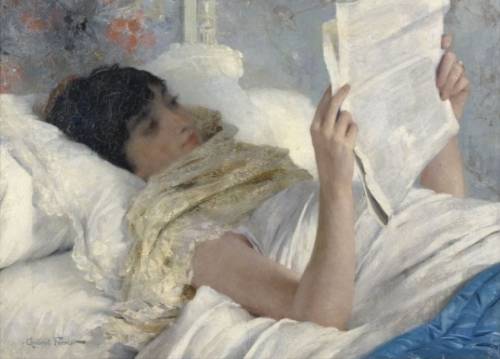My thyroid and I got along very well for a long time. We had a good relationship — I lived my life, and it provided me with the hormones I needed. There was that incident about twenty years ago, when suddenly I noticed a bump on my thyroid. It was about the size of a quarter, and filled with something — it felt like half of a water balloon. I went to an endocrinologist, who gave me a long talk about thyroid cancer that was, I think, more for the resident who was helping him than for me. He put a needle into the water balloon to get some fluid to test, and the water balloon deflated. The test came back negative. It had been nothing — a harmless cyst.
So when I felt a bump on my thyroid again, shortly after Christmas, I had some context for it. I knew approximately what it could be. I managed to get an appointment at the clinic where my primary care provider works — it took waiting for two weeks, and I would only be seeing a nurse practitioner. Apparently all the actual doctors were busy. The receptionist was also busy talking to her friend while I tried to make an appointment. That was the start of my journey in making appointments, and every appointment system was as bad as that first one. I have a theory that the most difficult part of healthcare in American is making an appointment with anyone anywhere. The second most difficult part is, of course, the billing system. I have tried to explain to European friends about “co-pays.” They stare at me blankly.
The nurse practitioner ordered a bunch of tests, all of which came back normal. She also requested an ultrasound, for which I had to go to Boston Medical Center. The ultrasound results came back. I had some nodes on my thyroid. They looked normal. No follow-up recommended. But I still had a bump on my throat. My mother, who happens to be a doctor, said, “You need to have it biopsied.” So I wrote to the nurse practitioner, I need to have it biopsied. She gave me a referral to an endocrinologist. I called to make an appointment.
It took a month and repeated phone calls to get an appointment. There was the phone call during which I was given an appointment in six months; the phone call during which I was told that no, that was just for patients coming back for checkups, and someone would call me back; the phone call during which I was told I needed to talk to Ashley; the one where Ashley was not available; the one in which I was told there had been a cancellation and I could come in tomorrow, and I had to explain that I was a professor and would be in the middle of teaching class; the phone call with Ashley; the follow-up phone call with Ashley. And then I had an appointment, a month from the day I talked to Ashley. (You can’t call Ashley or anyone else to make an appointment. You have to call the central number, click all the right buttons through the recorded message, wait to music you have not heard since the 1990s, and then talk to someone who tells you that someone else will call you back.)
Between the time that I got the appointment and the appointment itself, the bump on my throat disappeared. That happens sometimes. It doesn’t mean there wasn’t an underlying problem. Anyway, I already had an appointment with an endocrinologist, so I went — just to make sure the bump had, indeed, been nothing to worry about.
The endocrinologist did another ultrasound herself. Apparently, the radiologist who read the first ultrasound had miscounted the number of nodules. There were in fact more than four, and most of them looked harmless, except two on the left side. “There’s a lot of vascularization there,” she said, holding a cold wand to my throat. I’m very lucky that I know what vascularization is. I mean, I have a PhD in English literature. It’s not a medical doctorate, but it is a doctorate in words — in what they mean, how they’re put together. It’s a doctorate in, when I don’t understand something, looking it up. At every point, dealing with the American medical system, I wondered how someone without an advanced degree in understanding language, someone who might not even be fluent in English, would deal with it. “We really should biopsy those specific nodules,” she said. So she did, with a long, thin needle.
The biopsy for the larger nodule came back “suspicious for malignancy.” Suspicious, not definite. Even if it’s definite, the problem with this kind of biopsy (an FNB, or fine needle biopsy) is that it’s never really definite. An FNB can only give you a percentage certainty. The official percentage for “suspicious” is a 15-30% chance of malignancy. That’s a very big chance that it’s not, in fact, malignant. But there’s only one way to be sure. “I recommend surgery,” said the endocrinologist. “I’ll have someone call you for an appointment with the surgeon.” So there I was in the appointment system again, but this time within Endocrinology. The Ashley of this system was called Blaise. Once you can speak to the Ashleys and Blaises of the world, everything goes smoothly. The trick is identifying who they are and then getting to them.
The surgeon and his colleague, a specialist in thyroid issues, did another ultrasound. Everything looked fine, they told me, other than those two nodules. My lymph nodes looked fine. The other side of my thyroid looked fine–the nodules there were harmless. But the side of my thyroid with the suspicious nodule, that side should go. They recommended a thyroid lobectomy, which means that the surgeon takes out half the thyroid. It’s serious surgery, but one with an excellent success rate. Even if the patient has thyroid cancer, the long-term survival rate is 99%. The one thing I remember from that first episode, twenty years ago, is the endocrinologist telling me, telling the resident, if you’re going to have cancer, thyroid cancer is the best kind to have.
The difficulty was, I didn’t know what I had. There was a 15-30% chance of malignancy, and a 70-85% chance that it wasn’t. That was the information I had, and I would have to make a decision based just on that. The FNB doesn’t give you certainty — it’s just a small number of cells pulled up through a needle. The only certainty comes after the surgery, when they do a full, real, official biopsy on the whole nodule. Then you know for sure. But by then, the decision has already been made.
I talked to the endocrinologist again. She said I could choose surgery, or I could put off the decision until the fall. We could do another FNB, although it would not necessarily give us more information. “What would you do if it were you?” I asked her. Surgery, she replied. I talked to the surgeon again. During my first conversation with him, I had almost laughed several times. It had been almost like being in class at medical school. Perhaps because he knew that my mother was a doctor, and that I was a university professor, he had explained everything very thoroughly, in all its complex uncertainty. I had wondered, again, what my experience with the American medical system would be like if I did not understand Latinate terminology. But knowing big words doesn’t help you make a decision in a situation like this. “What would you do if it were you?” I asked him over the phone. Surgery, he replied.
In the end, I decided based on two things. The first was something the surgeon said. “If everything on that side of your thyroid was clear and easy to observe,” he said, “I would be fine with waiting and doing another ultrasound. We could see if the nodule changed over time. But that side of your thyroid looks weird.” It was the word “weird” that struck me. You don’t really want an endocrine surgeon saying your thyroid looks weird. The other thing was that I have lived in this body a long time. I trust it. I know when it’s trying to tell me something. First, it sent me a bump. The bump did not go away until I had already made an appointment with an endocrinologist. I think my body was trying to get my attention. Since then, I’ve been able to feel, not always but sometimes, that there’s something wrong on that side of my throat. I can feel a sort of pressure in a particular spot. It makes me just a little breathless and gives me a slight cough. When I told the surgeon about this, he looked at me skeptically. “Maybe you can feel the nodule inside your throat,” he said. “You have a thin throat, so you might be able to feel it.” In my experience, doctors never believe that you understand your own body. They’re pretty sure they know better than you — after all, that’s what they were taught in medical school. They’re the experts on bodies. But I’ve lived in my body a long time, and I know when something’s not right.
So that’s it. On Thursday I’ll have surgery. Theoretically, the side of my thyroid that is left should take over the function of the whole thyroid. Hopefully I won’t need medication, but we’ll see. I’ll have a scar on my throat. I plan to tell everyone that it comes from the time when I was a pirate queen. Or that I got it dueling in France, but you should see what I did to the Countess. Or that I usually wear a velvet ribbon, and watch out because my head might fall off.
More prosaically, I’ll do my best to get through end-of-semester grading. Then Budapest, then London, then the rest of my life. Half a thyroid is better than none, and I hope we will go on many more adventures together.

(The image is Woman Reading in Bed by Gabriel Ferrier. This is what I plan to look like for about a week after the surgery.)







